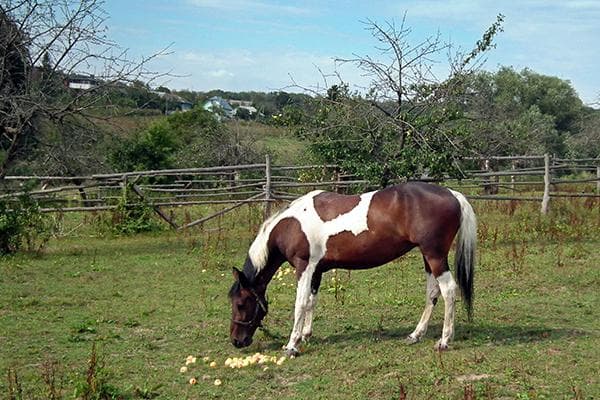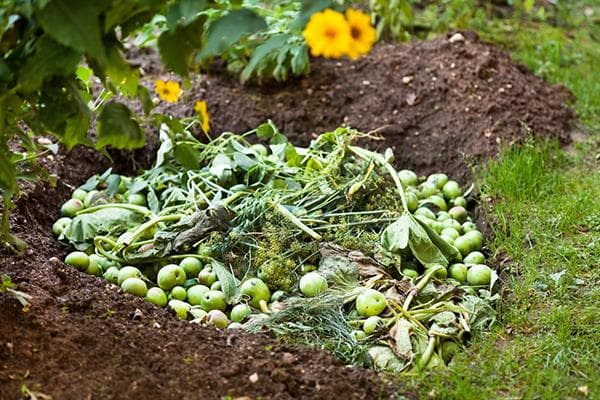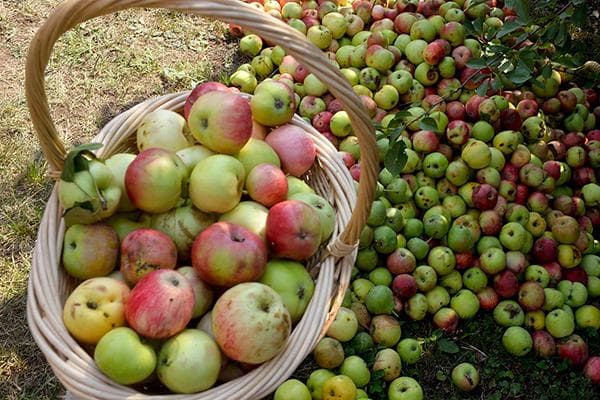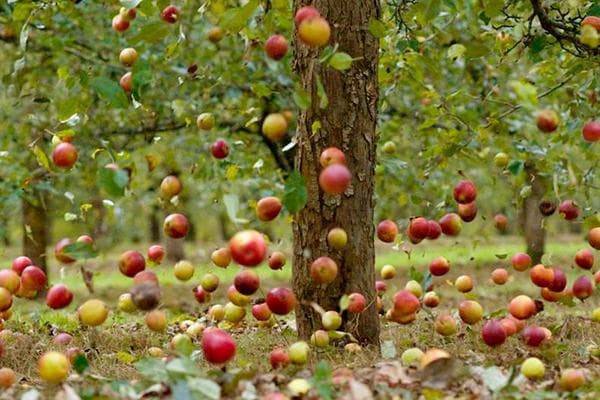Apples fall from the apple tree - what to do with them next?
Often gardeners have no idea what to do with falling apples. They are unsuitable for storage, and it is impossible to consume the entire volume of carrion. In addition, many fruits turn out to be affected by worms or rot. However, you can benefit from them.

Animal food
Apples that have fallen from a tree are a useful vitamin supplement to the diet of farm animals. Even slightly spoiled fruits are eaten with pleasure:
- horses;
- pigs;
- goats;
- sheep;
- cows;
- chickens.
If you don't have a barnyard, your neighbors probably do. You can make a deal: carrion from your garden in exchange for your neighbor's manure. Mullein and horse manure are almost universal fertilizers for vegetable and fruit crops.
You can do charity work and take fallen apples to a zoo or equestrian club. Such “gifts” are always welcome here.
Organic fertilizer
Apples are organic matter that quickly rots. However, it is not recommended to add carrion to compost, especially if you plan to use it to fertilize berry fields and fruit crops: there is a high probability of obtaining a slippery putrefactive mass full of pathogens.
Proper compost is made from moistened hay and manure. At the end of cooking, it emits a pleasant smell of freshly baked bread crust with a slight hint of ammonia. There is little nitrogen in its composition, which apples are full of.It is important to maintain the proportion: 1 part nitrogen to 20 parts carbon.
If you decide to compost the carrion, you should use fruits without signs of disease and in small quantities.
Recipes
You can prepare fertilizer from fallen apples in different ways. Here are a few recipes.
- Compost.
Place dry grass clippings and leaves at the bottom of the compost pit. Moisten them and leave for 2 weeks. Then pour out the apples, hay again, and soil. To speed up the process, you can use manure or special preparations (“EM”, others). To suppress the development of pathogenic microorganisms, urea is added to the compost pit. After 2–3 months, the compost can be used to fertilize tomatoes, cucumbers, zucchini, and pumpkins. Fertilizer must be mixed with ash, dolomite flour or chalk - they help neutralize acidity.
- Liquid feeding.
Place the fallen apples in a large barrel. Fill it about a third full. Next, pour water so that it does not reach 20 cm from the edge. Leave it in the sun for 2 weeks. The fertilizer turns out to be very powerful, almost the same as slurry. It is diluted 1 to 10.
The downside is that the liquid smells bad during the fermentation process. Therefore, it is better to place the barrel away from residential buildings.
Along with apples, you can put cut grass and weeds in a barrel.
- Dry feeding.
Cut whole apples without worms or signs of rotting into pieces and scatter them under raspberry, blackberry, currant, and gooseberry bushes. Cover with soil and spill with urea solution (1 tablespoon per 10 liters of water).
Preparations for the winter
Even whole beautiful apples will not be stored for long after falling from the tree. Therefore, they must be eaten immediately. You can squeeze juice, make purees, prepare charlotte and compotes.But, as practice shows, there is too much carrion, and it is impossible to eat it all.
Fallen apples can be processed and prepared for the winter:
- drying;
- jam in pieces;
- jam;
- juice;
- puree;
- vinegar;
- marshmallow;
- soaked apples.
Recipes
If not all, then many housewives are familiar with the preparation of jam, juice and marmalade. Here's how to prepare vinegar and apple marshmallow:
- Paste.
The original Russian dish is prepared as follows: washed and chopped apples are poured with a small amount of water and cooked over low heat for 30 minutes, stirring constantly. Then the pieces are pureed using a blender (sieve) and boiled until thick. At the next stage, the puree is distributed on parchment in a layer of 0.5 cm and placed to dry in an oven preheated to 100 degrees for 3–4 hours. The door is left ajar.
- Apple vinegar.
Apples need to be washed and damaged parts removed. The remainder is grated and poured into a glass jar. Then add honey at the rate of 100 g per 1 kg of apples and pour water so that all the apples are under water. The jar is covered with gauze and sent to a dark place for 10 days. The slurry is stirred every day. After the specified time, filter the liquid part, add 2 tbsp. tablespoons of honey and leave under gauze in a dark, warm place for 6–7 weeks. The jar is not touched at this time. The vinegar is ready. It is necessary to remove the formed film from the surface and drain the clear liquid, leaving sediment at the bottom.
Questions and answers
How to reduce the volume of carrion?
If apples fall from an apple tree in large numbers, this may mean that they have reached maturity and the entire harvest can be harvested. The cause of mass falling of unripe fruits is most often an attack by a codling moth or improper care of the tree.In the first case, catching belts and traps will help, in the second - abundant watering and fertilizing.
How to properly dispose of carrion?
Making a dump of fallen apples, even on the outskirts of the site, is not the best idea. Rotting on the surface, they will emit an extremely unpleasant odor and attract flies and wasps. It is correct to bury the carrion to a depth of 40–50 cm. The most convenient way is to dig a trench and rake the apples. To prevent the earth from becoming too acidic, the burial site should be sprinkled generously with ash. In this case, it is better to burn sick, mummified apples in a fire.
Apples that have fallen from a tree are dangerous to leave unattended. If they rot under the apple tree, they will not bring any benefit and can lead to unnecessary problems. Carrion becomes food for ants and caterpillars, as well as pathogenic fungi and bacteria. It is advisable to clean it every day. Whole apples can be used for harvesting; damaged apples can be fed to livestock or processed into fertilizer. If you use three methods of application at once, then there will be practically no waste left to be disposed of.


